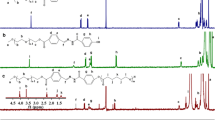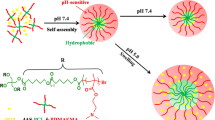Abstract
Well-defined biodegradable, pH-sensitive amphiphilic block polymers, poly(ethylene glycol)-Hyd-poly(lactic acid) (mPEG-Hyd-PLA) which have acid-cleavable linkages in their backbones, were synthesized via ring-opening polymerization initiated from hydrazone-containing macroinitiators. Introducing a hydrazone bond onto the backbone of an amphiphilic copolymer will find a broad-spectrum encapsulation of hydrophobic drugs. Dynamic light scattering (DLS) and transmission electron microscopy showed that the diblock copolymers self-assembled into stable micelles with average diameters of 100 nm. The mean diameters and size distribution of the hydrazone-containing micelles changed obviously in mildly acidic pH (multiple peaks from 1 to 202 nm appeared under a pH 4.0 condition) than in neutral, while there were no changes in the case of non-sensitive ones. Doxorubicin (DOX) and paclitaxel (PTX) were loaded with drug loading content ranging from 2.4 to 3.5 %, respectively. Interestingly, the anticancer drugs released from mPEG-Hyd-PLA micelles could also be promoted by the increased acidity. An in vitro cytotoxicity study showed that the DOX-loaded mPEG-Hyd-PLA micelles have significantly enhanced cytotoxicity against HepG2 cells compared with the non-sensitive poly(ethylene glycol)-block-poly(lactic acid) (mPEG-PLA) micelles. Confocal microscopy observation indicated that more DOX were delivered into the nuclei of cells following 6 or 12 h incubation with DOX-loaded mPEG-Hyd-PLA micelles. In vivo studies on H22-bearing Swiss mice demonstrated the superior anticancer activity of DOX-loaded mPEG-Hyd-PLA micelles over free DOX and DOX-loaded mPEG-PLA micelles. These hydrazone-containing pH-responsive degradable micelles provide a useful strategy for antitumor drug delivery.










Similar content being viewed by others
References
Bae Y, Fukushima S, Harada A, Kataoka K (2003) Design of environment-sensitive supramolecular assemblies for intracellular drug delivery: polymeric micelles that are responsive to intracellular pH change. Angew Chem Int Ed 42(38):4640–4643. doi:10.1002/anie.200250653
Cao J, Su T, Zhang L, Liu R, Wang G, He B et al (2014) Polymeric micelles with citraconic amide as pH-sensitive bond in backbone for anticancer drug delivery. Int J Pharm 471(1–2):28–36. doi:10.1016/j.ijpharm.2014.05.010
Chen W, Meng F, Cheng R, Zhong Z (2010) pH-sensitive degradable polymersomes for triggered release of anticancer drugs: a comparative study with micelles. J Control Release 142(1):40–46. doi:10.1016/j.jconrel.2009.09.023
Cheng J, Ji R, Gao S-J, Du F-S, Li Z-C (2012) Facile synthesis of acid-labile polymers with pendent ortho esters. Biomacromolecules 13(1):173–179. doi:10.1021/bm201410c
Cui C, Xue Y-N, Wu M, Zhang Y, Yu P, Liu L, Zhuo R-X, Huang S-W (2013) Cellular uptake, intracellular trafficking, and antitumor efficacy of doxorubicin-loaded reduction-sensitive micelles. Biomaterials 34:3858–3869. doi:10.1016/j.biomaterials.2013.01.101
Ding J, Xiao C, Li Y, Cheng Y, Wang N, He C, Zhuang X, Zhu X, Chen X (2013a) Efficacious hepatoma-targeted nanomedicine self-assembled from galactopeptide and doxorubicin driven by two-stage physical interactions. J Control Release 169:193–203. doi:10.1016/j.jconrel.2012.12.006
Ding J, Xu W, Zhang Y, Sun D, Xiao C, Liu D, Zhu X, Chen X (2013b) Self-reinforced endocytoses of smart polypeptide nanogels for "on-demand" drug delivery. J Control Release 172:444–455. doi:10.1016/j.jconrel.2013.05.029
Ding C, Gu J, Qu X, Yang Z (2009) Preparation of multifunctional drug carrier for tumor-specific uptake and enhanced intracellular delivery through the conjugation of weak acid labile linker. Bioconjug Chem 20(6):1163–1170. doi:10.1021/bc800563g
Gabizon AA (1995) Liposome circulation time and tumor targeting: implications for cancer chemotherapy. Adv Drug Deliv Rev 16:285–294. doi:10.1016/0169-409X(95)00030-B
Gao W, Chan JM, Farokhzad OC (2010) pH-responsive nanoparticles for drug delivery. Mol Pharm 7:1913–1920. doi:10.1021/mp100253e
Gillies ER, Goodwin AP, Fréchet JMJ (2004) Acetals as pH-sensitive linkages for drug delivery. Bioconjug Chem 15:1254–1263. doi:10.1021/bc049853x
Gupta R, Shea J, Scafe C, Shurlygina A, Rapoport N (2015) Polymeric micelles and nanoemulsions as drug carriers: therapeutic efficacy, toxicity, and drug resistance. J Control Release 212:70–77. doi:10.1016/j.jconrel.2015.06.019
Hrubý M, Koňák Č, Ulbrich K (2005) Polymeric micellar pH-sensitive drug delivery system for doxorubicin. J Control Release 103(1):137–148. doi:10.1016/j.jconrel.2004.11.017
Hu X, Liu S, Huang Y, Chen X, Jing X (2010) Biodegradable block copolymer-doxorubicin conjugates via different linkages: preparation, characterization, and in vitro evaluation. Biomacromolecules 11:2094–2102. doi:10.1021/bm100458n
Huang F, Cheng R, Meng F, Deng C, Zhong Z (2015) Micelles based on acid degradable poly(acetal urethane): preparation, pH-sensitivity, and triggered intracellular drug release. Biomacromolecules 16:2228–2236. doi:10.1021/acs.biomac.5b00625
Kataoka K, Harada A, Nagasaki Y (2001) Block copolymer micelles for drug delivery: design, characterization and biological significance. Adv Drug Deliv Rev 47:113–131. doi:10.1016/S0169-409X(00)00124-1
Koutroumanis KP, Holdich RG, Georgiadou S (2013) Synthesis and micellization of a pH-sensitive diblock copolymer for drug delivery. Int J Pharm 455(1–2):5–13. doi:10.1016/j.ijpharm.2013.06.071
Kwon G, Naito M, Yokoyama M, Okano T, Sakurai Y, Kataoka K (1993) Micelles based on AB block copolymers of poly(ethylene oxide) and poly(β-benzyl L-aspartate). Langmuir 9(4):945–949. doi:10.1021/la00028a012
Li N, Li N, Yi Q, Luo K, Guo C, Pan D, Gu Z (2014) Amphiphilic peptide dendritic copolymer-doxorubicin nanoscale conjugate self-assembled to enzyme-responsive anti-cancer agent. Biomaterials 35:9529–9545. doi:10.1016/j.biomaterials.2014.07.059
Liu C, Yuan J, Luo X, Chen M, Chen Z, Zhao Y, Li X (2014) Folate-decorated and reduction-sensitive micelles assembled from amphiphilic polymer-camptothecin conjugates for intracellular drug delivery. Mol Pharm 11:4258–4269. doi:10.1021/mp500468d
Loh XJ, Colin Sng KB, Li J (2008) Synthesis and water-swelling of thermo-responsive poly(ester urethane)s containing poly(ε-caprolactone), poly(ethylene glycol) and poly(propylene glycol). Biomaterials 29(22):3185–3194. doi:10.1016/j.biomaterials.2008.04.015
Lu J, Li N, Xu Q, Ge J, Lu J, Xia X (2010) Acetals moiety contained pH-sensitive amphiphilic copolymer self-assembly used for drug carrier. Polymer 51(8):1709–1715. doi:10.1016/j.polymer.2009.12.034
Lv S, Tang Z, Zhang D, Song W, Li M, Lin J, Liu H, Chen X (2014) Well-defined polymer-drug conjugate engineered with redox and pH-sensitive release mechanism for efficient delivery of paclitaxel. J Control Release 194:220–227. doi:10.1016/j.jconrel.2014.09.009
Man DKW, Casettari L, Cespi M, Bonacucina G, Palmieri GF, Sze SCW, Leung GPH, Lam JKW, Kwok PCL (2015) Oleanolic acid loaded PEGylated PLA and PLGA nanoparticles with enhanced cytotoxic activity against cancer cells. Mol Pharm 12:2112–2125. doi:10.1021/acs.molpharmaceut.5b00085
Prabaharan M, Grailer JJ, Pilla S, Steeber DA, Gong S (2009) Amphiphilic multi-arm-block copolymer conjugated with doxorubicin via pH-sensitive hydrazone bond for tumor-targeted drug delivery. Biomaterials 30:5757–5766. doi:10.1016/j.biomaterials.2009.07.020
Sala F, Kay ER (2015) Reversible control of nanoparticle functionalization and physicochemical properties by dynamic covalent exchange. Angew Chem Int Ed 54:4187–4191. doi:10.1002/anie.201409602
Sato K, Yoshida K, Takahashi S, Anzai J-I (2011) pH- and sugar-sensitive layer-by-layer films and microcapsules for drug delivery. Adv Drug Deliv Rev 63:809–821. doi:10.1016/j.addr.2011.03.015
Seo B-B, Choi H, Koh J-T, Song S-C (2015) Sustained BMP-2 delivery and injectable bone regeneration using thermosensitive polymeric nanoparticle hydrogel bearing dual interactions with BMP-2. J Control Release 209:67–76. doi:10.1016/j.jconrel.2015.04.023
Sun H, Guo B, Li X, Cheng R, Meng F, Liu H, Zhong Z (2010) Shell-sheddable micelles based on dextran-SS-poly(epsilon-caprolactone) diblock copolymer for efficient intracellular release of doxorubicin. Biomacromolecules 11:848–854. doi:10.1021/bm1001069
Takae S, Miyata K, Oba M, Ishii T, Nishiyama N, Itaka K, Yamasaki Y, Koyama H, Kataoka K (2008) PEG-detachable polyplex micelles based on disulfide-linked block catiomers as bioresponsive nonviral gene vectors. J Am Chem Soc 130:6001–6009. doi:10.1021/ja800336v
Tang R, Ji W, Panus D, Palumbo RN, Wang C (2011) Block copolymer micelles with acid-labile ortho ester side-chains: synthesis, characterization, and enhanced drug delivery to human glioma cells. J Control Release 151:18–27. doi:10.1016/j.jconrel.2010.12.005
Torchilin VP (2001) Structure and design of polymeric surfactant-based drug delivery systems. J Control Release 73:137–172. doi:10.1016/S0168-3659(01)00299-1
Webb BA, Chimenti M, Jacobson MP, Barber DL (2011) Dysregulated pH: a perfect storm for cancer progression. Nat Rev Cancer 11:671–677. doi:10.1038/nrc3110
Wu W, Yao W, Wang X, Xie C, Zhang J, Jiang X (2015) Bioreducible heparin-based nanogel drug delivery system. Biomaterials 39:260–268. doi:10.1016/j.biomaterials.2014.11.005
Zhan F, Chen W, Wang Z, Lu W, Cheng R, Deng C, Meng F, Liu H, Zhong Z (2011) Acid-activatable prodrug nanogels for efficient intracellular doxorubicin release. Biomacromolecules 12:3612–3620. doi:10.1021/bm200876x
Zhang L, Wang Y, Yang Y, Liu Y, Ruan S, Zhang Q, Tai X, Chen J, Xia T, Qiu Y, Gao H, He Q (2015) High tumor penetration of paclitaxel loaded pH sensitive cleavable liposomes by depletion of tumor collagen I in breast cancer. ACS Appl Mater Interfaces 7:9691–9701. doi:10.1021/acsami.5b01473
Zheng H, Hua D, Bai R, Hu K, An L, Pan C (2007) Controlled/living free-radical copolymerization of 4-(azidocarbonyl) phenyl methacrylate with methyl acrylate under Co-60 gamma-ray irradiation. J Polym Sci Pol Chem 45:2609–2616. doi:10.1002/pola.22018View
Zhou L, Liang D, He X, Li J, Tan H, Li J, Fu Q, Gu Q (2012) The degradation and biocompatibility of pH-sensitive biodegradable polyurethanes for intracellular multifunctional antitumor drug delivery. Biomaterials 33:2734–2745. doi:10.1016/j.biomaterials.2011.11.009
Zhou L, Yu L, Ding M, Li J, Tan H, Wang Z, Fu Q (2011) Synthesis and characterization of pH-sensitive biodegradable polyurethane for potential drug delivery applications. Macromolecules 44:857–864. doi:10.1021/ma102346a
Zou Y, Song Y, Yang W, Meng F, Liu H, Zhong Z (2014) Galactose-installed photo-crosslinked pH-sensitive degradable micelles for active targeting chemotherapy of hepatocellular carcinoma in mice. J Control Release 193:154–161. doi:10.1016/j.jconrel.2014.05.016
Acknowledgments
This work was supported by the National Natural Science Foundation of China (NSFC 51375142), Research Fund for Excellent Young College Teachers of Henan Province and a Key Project Funded by the Education Department of Henan Province. Thanks to Professor Gangjun Du for his valuable advice and help in the animal experiments.
Author information
Authors and Affiliations
Corresponding author
Ethics declarations
All animal experiments were performed in accordance with the principles of care and use of laboratory animals and were approved by the experimental animal administrative committee of Henan University.
Additional information
Jing Xu and Shujuan Luan contributed equally to this work.
Rights and permissions
About this article
Cite this article
Xu, J., Luan, S., Qin, B. et al. Backbone-hydrazone-containing biodegradable copolymeric micelles for anticancer drug delivery. J Nanopart Res 18, 316 (2016). https://doi.org/10.1007/s11051-016-3626-4
Received:
Accepted:
Published:
DOI: https://doi.org/10.1007/s11051-016-3626-4




